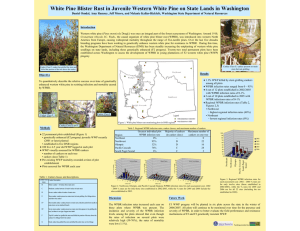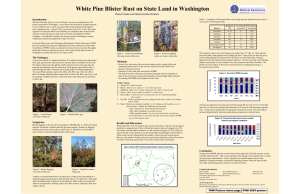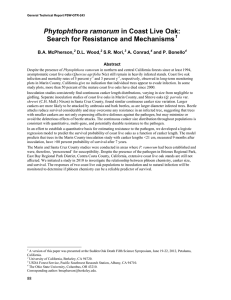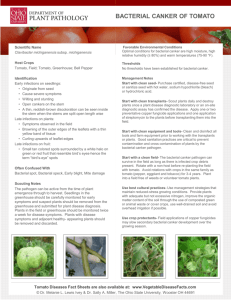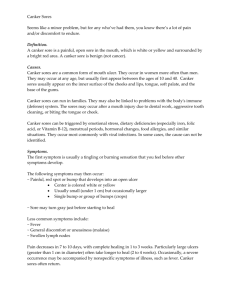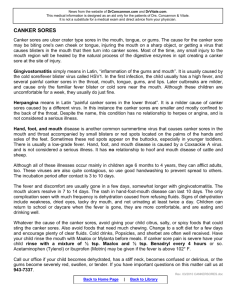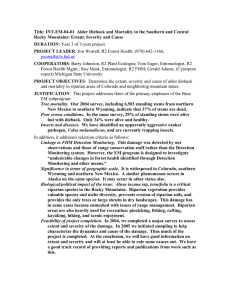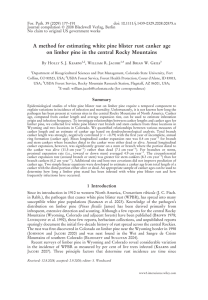White Pine Blister Rust in Juvenile Western White Pine on...
advertisement
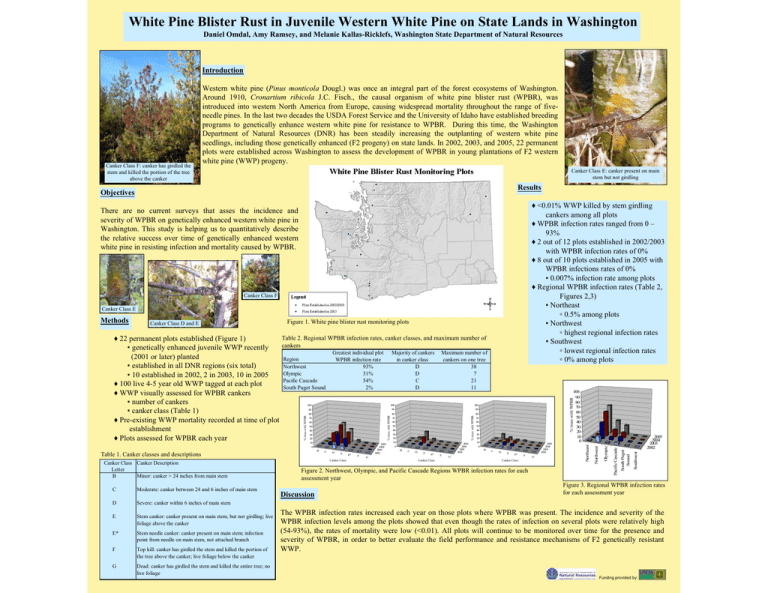
White Pine Blister Rust in Juvenile Western White Pine on State Lands in Washington Daniel Omdal, Amy Ramsey, and Melanie Kallas-Ricklefs, Washington State Department of Natural Resources Introduction Canker Class F: canker has girdled the stem and killed the portion of the tree above the canker Western white pine (Pinus monticola Dougl.) was once an integral part of the forest ecosystems of Washington. Around 1910, Cronartium ribicola J.C. Fisch., the causal organism of white pine blister rust (WPBR), was introduced into western North America from Europe, causing widespread mortality throughout the range of fiveneedle pines. In the last two decades the USDA Forest Service and the University of Idaho have established breeding programs to genetically enhance western white pine for resistance to WPBR. During this time, the Washington Department of Natural Resources (DNR) has been steadily increasing the outplanting of western white pine seedlings, including those genetically enhanced (F2 progeny) on state lands. In 2002, 2003, and 2005, 22 permanent plots were established across Washington to assess the development of WPBR in young plantations of F2 western white pine (WWP) progeny. Canker Class E: canker present on main stem but not girdling Results Objectives ♦ <0.01% WWP killed by stem girdling cankers among all plots ♦ WPBR infection rates ranged from 0 – 93% ♦ 2 out of 12 plots established in 2002/2003 with WPBR infection rates of 0% ♦ 8 out of 10 plots established in 2005 with WPBR infections rates of 0% ▪ 0.007% infection rate among plots ♦ Regional WPBR infection rates (Table 2, Figures 2,3) ▪ Northeast ▫ 0.5% among plots ▪ Northwest ▫ highest regional infection rates ▪ Southwest ▫ lowest regional infection rates ▫ 0% among plots There are no current surveys that asses the incidence and severity of WPBR on genetically enhanced western white pine in Washington. This study is helping us to quantitatively describe the relative success over time of genetically enhanced western white pine in resisting infection and mortality caused by WPBR. Canker Class F Canker Class E Figure 1. White pine blister rust monitoring plots 80 60 50 40 30 20 10 2005 2004 2003 2002 0 B Table 1. Canker classes and descriptions Canker Class Canker Description Letter B Minor: canker > 24 inches from main stem C Moderate: canker between 24 and 6 inches of main stem D Severe: canker within 6 inches of main stem E Stem canker: canker present on main stem, but not girdling; live foliage above the canker E* Stem needle canker: canker present on main stem; infection point from needle on main stem, not attached branch F Top kill: canker has girdled the stem and killed the portion of the tree above the canker; live foliage below the canker G Dead: canker has girdled the stem and killed the entire tree; no live foliage C D E Canker Class E* F 70 60 50 40 30 20 10 2005 2004 2003 2002 0 B C D E E* G Canker Class F G 70 60 50 40 30 20 10 2005 2004 2003 2002 0 B C D E E* F Canker Class Figure 2. Northwest, Olympic, and Pacific Cascade Regions WPBR infection rates for each assessment year Discussion G 2005 2004 2003 2002 Southwest 90 80 70 South Puget Sound 90 80 Olympic 90 100 90 80 70 60 50 40 30 20 10 0 Pacific Cascade 100 % trees with WPBR 100 % trees with WPBR 100 % trees with WPBR % trees with WPBR Table 2. Regional WPBR infection rates, canker classes, and maximum number of ♦ 22 permanent plots established (Figure 1) cankers ▪ genetically enhanced juvenile WWP recently Greatest individual plot Majority of cankers Maximum number of (2001 or later) planted Region WPBR infection rate in canker class cankers on one tree ▪ established in all DNR regions (six total) Northwest 93% D 38 Olympic 31% D 7 ▪ 10 established in 2002, 2 in 2003, 10 in 2005 Pacific Cascade 54% C 21 ♦ 100 live 4-5 year old WWP tagged at each plot South Puget Sound 2% D 11 ♦ WWP visually assessed for WPBR cankers ▪ number of cankers ▪ canker class (Table 1) ♦ Pre-existing WWP mortality recorded at time of plot establishment ♦ Plots assessed for WPBR each year Northeast Canker Class D and E Northwest Methods Figure 3. Regional WPBR infection rates for each assessment year The WPBR infection rates increased each year on those plots where WPBR was present. The incidence and severity of the WPBR infection levels among the plots showed that even though the rates of infection on several plots were relatively high (54-93%), the rates of mortality were low (<0.01). All plots will continue to be monitored over time for the presence and severity of WPBR, in order to better evaluate the field performance and resistance mechanisms of F2 genetically resistant WWP. Funding provided by:
